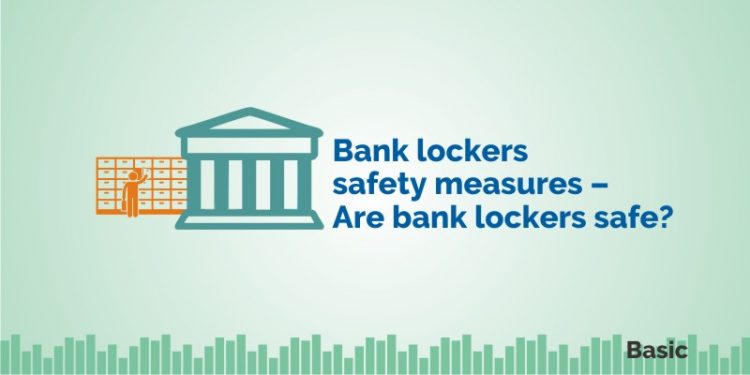In this article, we would be covering about bank lockers safety measures that can help you safeguard your valuables.
It’s a mass general belief that bank lockers are the safest place to store valuable jewelries, important documents, share certificates or the things precious to you. Both the public and private sector banks offers bank lockers safety facility to individuals for annual charges of Rs.1,000 to Rs.10,000 for small to medium and large sizes and charges varies based on locations too.
Bank locker operates with two keys – one kept with the bank and other given to you. Both the keys are required to open the locker and access your valuables.
Is bank locker the safest one to store valuables?
Bank lockers are supposed to be safer than home with all the multiple layers of securities and surveillance they provide. However, thinking that bank lockers are the safest place to secure valuables is inappropriate.
In November 2017, 25 feet tunnel had been dug up by the robbers into a Bank of Baroda branch, Navi Mumbai and they have stolen more than Rs.2.85 crore worth of gold, silver, jewelleries and cash from 27 lockers. Suddenly, this is not the first case of bank robbery or theft in India.
In Feb 2018, unknown criminals in disguise broke into the Union Bank of India’s Kanpur branch and emptied 26 lockers, which contained jewellery, cash and documents of the customers.
Download E-Book to Learn for Free: Banking Awareness Book
According to the Union ministry for finance, robbery, theft and burglary accounted for Rs.1.80 bn loss in 2,632 cases across India’s 51 banks from 2014-15 to 2016-17.
Hence, looking at the frequent newspaper headlines related to bank lockers robbery, it is very important to analyse independently how safe your bank locker is and what are the bank lockers safety measures one can take.
Are banks liable for locker thefts or loss?
Bank is not legally responsible for any loss. The bank locker agreements state: “the bank is not responsible for any loss or deterioration of or damage to the contents of the locker whether caused by rain, fire, flood, earthquake, lightening, civil commotion, war, riot or any other cause/s not in the control of the bank.”
The relation between bank and its customer who avails the locker facility is like a landlord and tenant. Banking customer pays locker rent for keeping their valuables in the safe place. Landlord collects rent from tenant and is not responsible for theft inside the house. Similarly, bank does not check what you keep inside the locker and thus the actual amount of loss cannot be ascertain and compensate.
However as per RBI Guidelines, banks must maintain adequate safety measures to safeguard the lockers and ongoing surveillance and review of its security facility to eliminate all the loopholes.
Should you go for bank locker insurance to safeguard your valuable contents?
Banks are neither responsible for the any loss to the contents kept in locker nor they provide any insurance cover for the valuables kept inside a locker. Therefore, to ensure bank lockers safety, the best way is to safeguard your valuable contents is to either buy separate jewellery insurance or content insurance against theft and damage.
Recently there are some home insurance policies available in the market, which cover valuables kept inside bank lockers as a part of their policy. You need to specify whether you want to cover the valuables lying in the house, on you or in bank lockers. But each company has its own caveats and restrictions.
For example: Bajaj Allianz’s My Home Insurance All Risk Policy covers precious metal jewellery, watches, diamonds, works of art and curios with the limit of Rs.10 lakhs, above which valuation certificate from a government-approved valuer is required.
Suggested Read: 22 Important Banking Terms you need to know
Royal Sundaram Gruh Suraksha Plan restricts the cover to jewellery, silverware and watches.
But there is no insurance available for the important documents, cash or any other valuables.
However, one may think to keep valuables at home and only buy insurance cover against theft. Meanwhile bank lockers are safer and secured than the house, the insurance on bank lockers are less expensive with majorly paper work involved. Thus, hiring locker on rent and insurance cover for its contents will insure double safety for your valuables.
Apart from robbery, we frequently read in newspaper that some false person has access the locker of another person and have stolen the valuables and cash inside.
What all bank lockers safety measures can be taken?
Thus, there are few points to learn about bank lockers and how to keep your precious belongings safe.
- How safe is your bank? – Ask the bank about the security structure in place to protect valuables such as alarm system, iron gate rooms, cctv etc.
- Read all terms and conditions when hiring a locker.
- Open the locker as a joint account holder and mention nominee so that locker can be operated in any worst case.
- Always open your locker once the bank employee who attends you vacate the place.
- Make sure locker is properly closed before leaving.
- Always choose the nearest trusted branch for locker so that you can frequently visit to ensure that all your valuables are safe.
- Prepare list of all the valuables kept in locker along with its worth.
- Laminate the documents such as property papers, share certificate etc. kept in locker for long lasting and keep their copies.
- Before providing locker to you, banks classify you in risk category: high/medium/low. In case of high risk category, if locker holder does not operate it for one year, bank has the right to break open his locker after giving a notice.
What if there is loss due to bank’s negligence?
Banks providing safety deposit lockers are supposed to ensure that lockers are safe in all aspects. If the loss occurs due to loopholes and negligence from bank’s side then customer can claim the complete loss.
A very shocking incident happened in 2007 when termites ate Dwarika Prasad’s Rs.4.5 lakh cash and FD papers, Kisan Vikas Patras and NSCs worth Rs.2.5 lakh in the locker of Central Bank of India’s Patna branch. In this case the customer was fully compensated as the loss was due to bank’s negligence.
Further in case of theft, if it is proved that bank employee is involved, the customer can also claim the loss. In any case customer must submit evidence of the extent of the loss happened.
Conclusion
Excluding a few cases of theft and robbery at bank lockers each year, they are still the safer place than home to keep your valuables. Further one may choose to divided valuables between home and locker to reduce geographical risk. Insuring valuables will have an added benefit.
In order to get the latest updates on Financial Markets visit https://stockedge.com/







Great article thanks for sharing
Welcome
Great blog thanks for sharing
Hi,
Thank You for your comment!
Keep Reading!
Thanks for sharing such an informative article
Hi,
Welcome!!
Keep Reading!!
Thanks for sharing such an informative blog
Hi,
Thank You!
Keep Reading!
Thanks for sharing such an informative article
Hi,
Thank You !!
Keep Reading!
Great Blog Nice Informative Content
Hello,
Thank you for your comment.
Great informative article
Hello!
Thank You for Reading!
Keep Reading!
Thanks for sharing such an informative article
Hi,
Thank you for reading!
Keep Reading!
Great informative article thanks for sharing.
Hi,
Thank you for Reading!
Keep Reading
Dhanyavad acchi jankari mili
Hi,
Thank you for reading!
Keep Reading!
Great blog thanks for sharing.
Great blog thanks for sharing.
Great article thanks for sharing.